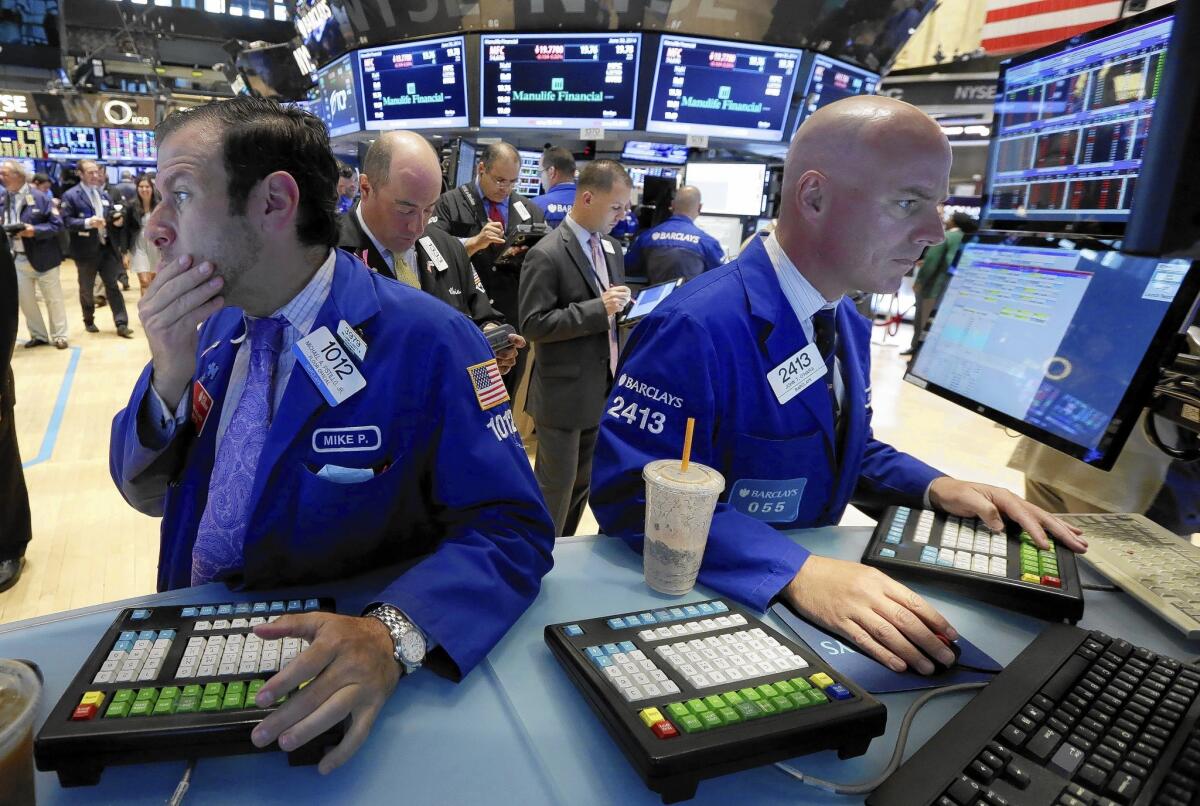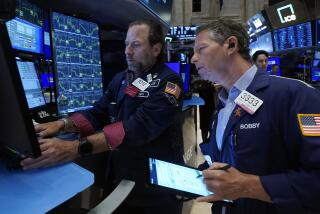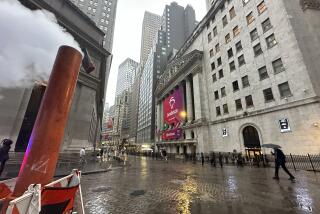Stock market grinds out gains in first half

It was a slow grind, but U.S. stocks posted gains in the second quarter and first half, extending the bull run into a sixth year.
In a surprise, investors also were rewarded for sticking with bonds, as interest rates resumed their decline after surging late in 2013. The latest drop in rates boosted the value of trillions of dollars in outstanding bonds.
On Wall Street, the Dow Jones industrial average edged up 2.2% in the second quarter and 1.5% in the first half. The Dow closed the quarter on Monday at 16,826.60, not far from its all-time high of 16,947 on June 20.
Many broader U.S. market indexes fared better than the blue-chip Dow, underscoring investors’ faith in the U.S. economic recovery. The Standard & Poor’s 500, a benchmark for retirement nest eggs, rose 4.7% in the quarter and 6% in the half. The technology-dominated Nasdaq composite was up 5% in the quarter and 5.5% in the half.
The broadest market gauge of all, the Wilshire 5,000 index, finished at a record high, up nearly 6% in the half.
Overseas, however, stock markets were more of a mixed bag in the first half of this year. European markets mostly edged up with the U.S. But Japanese stocks pulled back after last year’s surge. Emerging markets diverged sharply, with India soaring 20% after a new government swept into power, while Chinese stocks lost 3.2% and the Mexican market was nearly unchanged.
On the whole, stock markets held up well despite a raft of discouraging news. China’s economy continued to slow, burdened by a growing real estate glut. Europe’s economy remained mired near zero growth, and a brutal winter in the East and Midwest sapped U.S. growth in the first quarter.
In Iraq, the rise of a new militant group helped drive up world oil prices. U.S. crude futures in New York rose 7.1% in the first half to end at $105.37 a barrel, near the highest since September.
But stock investors weren’t much fazed by grim headlines.
“It’s a dismissive mind-set,” said Sam Stovall, chief equity strategist at Standard & Poor’s in New York. “Some of these things have been with us for so long, they’re unlikely to fell the market. The thing to worry about is the thing that comes out of the blue.”
History also is on the side of the bulls. “Good years tend to follow great years,” Stovall said, noting that the S&P 500 had rocketed almost 30% last year.
Stocks got help from another source in the half: corporate coffers. Cash-rich companies aggressively bought their own shares, and they also stepped up acquisitions, pushing merger activity to the highest level since 2007. A total of 4,589 deals worth $755 billion were announced in the U.S. in the first half, up from 4,135 deals worth $445 billion in the same period of last year, according to Thomson Reuters.
But some analysts are worried by glaring market contradictions this year. Both oil and gold prices rose in the half, classic warnings of higher inflation. Gold ended Monday at $1,322 an ounce, a 10% gain year to date. Yet global bond markets laughed off inflation jitters: Many investors again snapped up fixed-income securities, driving down yields.
Even as the Federal Reserve continued to pare back on its purchases of Treasury bonds and mortgage securities — the so-called tapering of its economic stimulus program — the bellwether 10-year T-note yield ended the half at 2.54%, down from 3.03% at the start of the year. Tax-free municipal bond yields also tumbled.
The latest decline in bond yields is good news for the millions of U.S. investors who have piled into fixed-income securities since the 2008 financial crash. Falling yields mean older bonds rise in value. That has helped lift popular “target date” retirement mutual fund portfolios, which typically own a mix of bonds and stocks. Most target-date funds rose between 5% and 6% in the half, according to Morningstar Inc.
Yet falling yields also suggest that bond buyers are pessimistic about global economic growth in the second half — the opposite message of a rising stock market.
In the U.S., the economy’s unexpected contraction in the first quarter was widely blamed on bad weather. Much of the economic data since then, including job growth, have pointed to a rebound.
But the one segment of the economy that still lags is the biggest: household consumption, said Russ Koesterich, chief investment strategist for BlackRock Inc. Americans’ personal spending rose just 0.2% in May after a flat April.
That spending weakness hit many consumer-related stocks. Shares of retailer Kohl’s Corp. were down 7.2% in the half, while Wal-Mart Stores Inc. fell 4.6% and Ross Stores Inc. slid 11.7%.
In another sign of caution, nervous investors this spring suddenly dumped many small-company stocks, along with some of last year’s highest fliers, such as Amazon Inc. and Tesla Motors Inc. But many of those battered stocks rebounded in June.
Overall, Wall Street still expects corporate earnings growth to pick up in the second half, supporting share prices. Operating earnings of the S&P 500 companies rose 5.6% in the first quarter, but analysts on average expect year-over-year growth of 6.6% in the second quarter, 11% in the third quarter and 12% in the fourth, according to Thomson Reuters.
For many stock market bulls, the only critical concern now is when the Federal Reserve will begin actually raising short-term interest rates, which have been held near zero since 2008.
At its June meeting the Fed indicated that most of its policy-making committee members expected to tighten credit next year. But Chairwoman Janet Yellen continued to stress that the central bank was in no hurry. Despite the upward trend this year in key inflation gauges, Yellen said the Fed didn’t believe prices would increase sharply enough to hurt the economy.
Ethan Harris, co-head of global economics for Bank of America Merrill Lynch, said the Fed was right not to overreact to recent inflation numbers, given the relative lack of workers’ wage growth. Price inflation will stay modest without wage inflation, he said.
“The Fed can afford to sit back and watch for a while,” Harris said.
More to Read
Inside the business of entertainment
The Wide Shot brings you news, analysis and insights on everything from streaming wars to production — and what it all means for the future.
You may occasionally receive promotional content from the Los Angeles Times.










